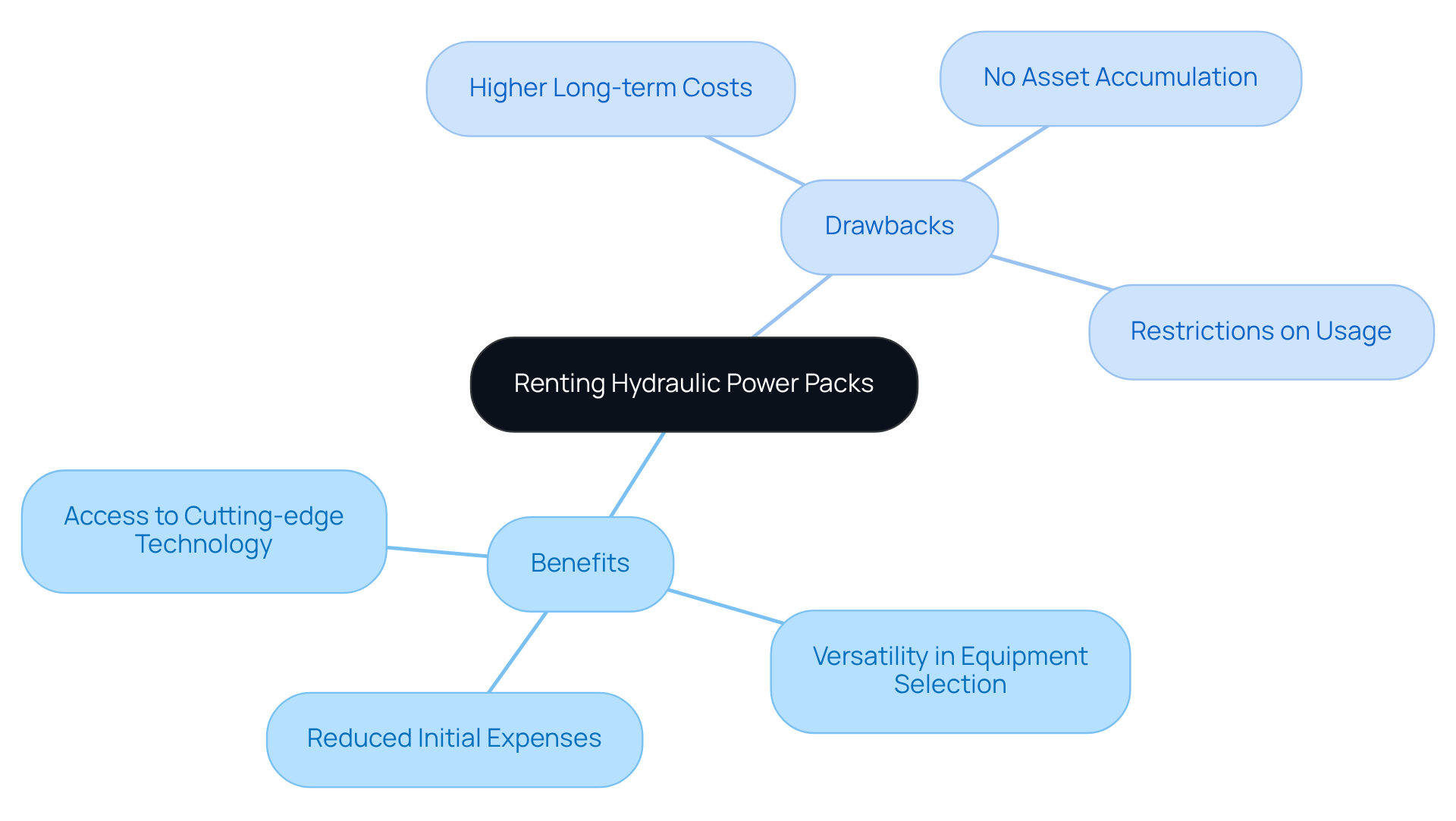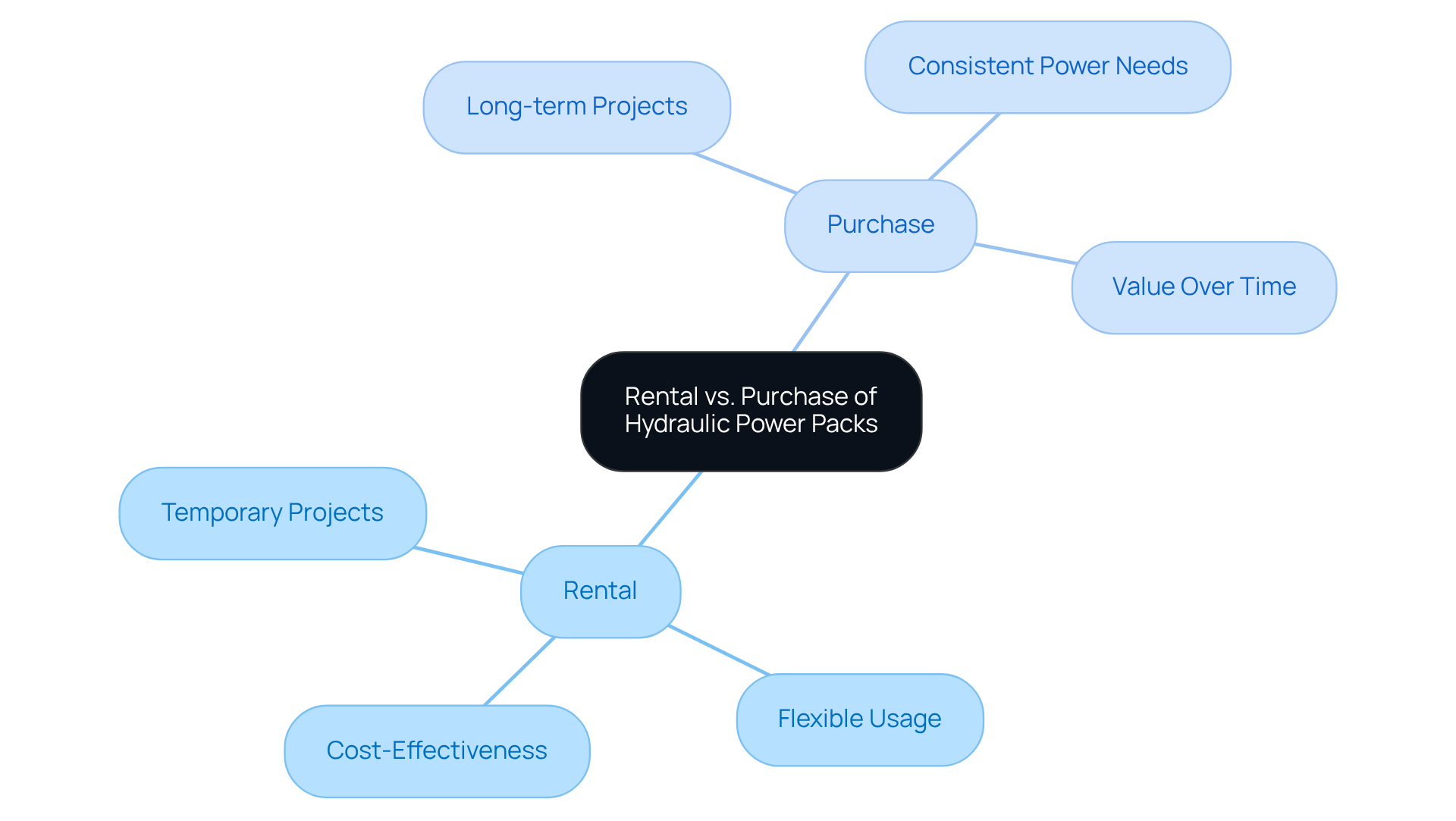Overview
When deciding between renting or purchasing hydraulic power packs, several key considerations must be evaluated:
- Project duration
- Frequency of use
- Budget constraints
- Specific energy requirements
Renting offers reduced initial costs and access to modern technology, making it an attractive option for short-term projects. In contrast, purchasing hydraulic power packs can provide significant long-term savings and greater control over maintenance. Ultimately, the choice hinges on the specific needs and financial strategy of the project, underscoring the importance of a tailored approach.
Key Highlights:
- Hydraulic power packs convert mechanical energy into fluid energy, essential in construction and manufacturing.
- They are widely used for operating heavy machinery like cranes and lifts, particularly in urban development.
- U.S. construction spending reached approximately $2,027.1 billion in October 2023, indicating increased reliance on hydraulic systems.
- The fluid energy system market is projected to grow from $7.18 billion in 2024 to $7.63 billion in 2025 due to technological advancements.
- Renting hydraulic power packs offers benefits like reduced initial costs and access to modern technology, but may lead to higher long-term expenses.
- Purchasing hydraulic power packs provides control over maintenance and potential long-term savings, but requires significant upfront investment.
- Key factors in deciding between renting and purchasing include project duration, frequency of use, budget constraints, and energy requirements.
- Effective decision-making regarding hydraulic power packs can significantly impact project outcomes.
Introduction
The construction and manufacturing industries increasingly rely on hydraulic power packs, which are essential for transforming mechanical energy into fluid power. As project managers face the critical decision of whether to rent or purchase these units, the stakes are high; this choice can significantly impact budget, efficiency, and operational success.
It is crucial to consider various factors to navigate the complexities of rental versus ownership. Understanding these elements ensures that the decision aligns with the unique demands of each project.
Understand Hydraulic Power Packs: Functionality and Applications
Hydraulic units serve as essential components across various sectors, adeptly transforming mechanical energy into fluid energy to power a wide range of systems. These self-sufficient units find extensive application in construction and manufacturing, energizing machinery such as cranes, lifts, and pneumatic tools. Their versatility allows for both stationary and mobile uses, rendering them indispensable for tasks that demand significant lifting or force.
In the construction industry, fluid systems are crucial for operating heavy equipment, especially as urban development drives infrastructure growth. For example, in October 2023, U.S. construction spending soared to an estimated $2,027.1 billion, marking a 10.7% increase from the previous year. This surge underscores the growing reliance on fluid systems to meet the demands of expanding construction activities. Industry leaders emphasize that the efficiency and reliability of fluid systems significantly enhance operational capabilities, particularly in high-demand environments.
Moreover, the manufacturing sector benefits from fluid energy units through improved efficiency in processes such as metal shaping and plastic injection molding. As industries increasingly adopt automation and sustainable practices, the demand for advanced fluid power solutions is expected to rise. The fluid energy system market is projected to grow from $7.18 billion in 2024 to $7.63 billion in 2025, driven by technological advancements and a focus on energy efficiency, in line with the escalating needs in construction.
Real-world examples illustrate the effectiveness of fluid-driven units in industrial settings. As managers evaluate their options, understanding the distinct applications of fluid equipment in construction versus manufacturing will aid them in making informed decisions about leasing for short-term projects or investing in long-term solutions.

Evaluate the Benefits and Drawbacks of Renting Hydraulic Power Packs
Leasing a hydraulic power pack rental presents a range of significant benefits. These include:
- Reduced initial expenses
- Versatility in equipment selection
- Access to cutting-edge technology without the burden of a long-term commitment
This flexibility is particularly advantageous for projects with fluctuating energy requirements or those that are time-sensitive.
However, it is essential to consider potential drawbacks. These include:
- Frequent equipment needs may lead to higher long-term costs
- The absence of ownership means no asset accumulation
- Rental agreements often come with restrictions on usage and maintenance responsibilities, which can complicate project management
In conclusion, while leasing hydraulic energy units offers immediate advantages, it is crucial to weigh these against the long-term implications. To explore our options for hydraulic power pack rental and find the right equipment for your needs, contact us today and experience the reliability and quality that sets us apart in the industry.

Assess the Advantages and Disadvantages of Purchasing Hydraulic Power Packs
Investing in fluid energy units represents a strategic decision for companies reliant on consistent equipment utilization. Ownership offers complete control over maintenance schedules and the flexibility to customize equipment to meet specific operational demands. Moreover, purchasing can lead to substantial long-term savings, especially for frequent users, as it eliminates ongoing rental fees. Once the equipment is paid off, businesses enjoy the benefit of no recurring rental costs, thereby enhancing financial predictability.
Financial analysts frequently emphasize that while acquiring equipment necessitates a significant upfront investment, it can translate into considerable savings over time. Furthermore, AI-powered maintenance has the potential to enhance fuel efficiency by 25% and reduce equipment failures by 73%, showcasing the operational efficiencies gained through ownership. However, it is crucial to consider the substantial initial capital investment alongside ongoing expenses related to maintenance, storage, and depreciation. Additionally, the risk of obsolescence due to rapid technological advancements may require businesses to invest in newer models sooner than anticipated.
Companies must also acknowledge the challenges associated with hydraulic power pack rental during peak seasons, which can lead to availability issues and delays in operations. Ultimately, weighing these factors carefully is essential for determining the most cost-effective approach tailored to specific circumstances. Engage with us today to explore how investing in fluid energy units can elevate your operational efficiency.

Compare Rental and Purchase: Making the Right Choice for Your Project
When managers in charge confront the decision of hydraulic power pack rental versus buying hydraulic units, several essential factors warrant careful assessment. Key considerations include:
- The duration of the project
- The frequency of equipment usage
- Budget constraints
- The specific energy requirements for the tasks at hand
For temporary assignments or those with fluctuating energy needs, a hydraulic power pack rental often proves to be the most economical and flexible choice. Conversely, long-term projects with consistent power demands may find purchasing advantageous, as it can provide superior value over time.
Recent statistics reveal that budget constraints are a significant concern for construction projects in 2025, with many managers reporting heightened scrutiny over equipment expenditures. This financial landscape underscores the necessity for a thorough analysis of both options. Ultimately, the decision should align with the project's financial strategy and operational goals, ensuring that the chosen approach effectively supports successful execution.
Project managers have observed that a well-informed decision can profoundly influence project outcomes, highlighting the importance of meticulous planning and consideration of all relevant factors. By weighing the benefits of renting against the advantages of purchasing, managers can make choices that not only meet immediate needs but also foster long-term success.

Conclusion
Evaluating whether to rent or purchase hydraulic power packs is a critical decision that requires a nuanced understanding of specific project needs and financial implications. The choice depends on key factors such as:
- Project duration
- Frequency of use
- Budget constraints
By recognizing the distinct advantages of both options, project managers can align their decisions with operational goals, ensuring optimal efficiency and cost-effectiveness.
Renting hydraulic power packs offers flexibility and reduced initial costs, making it particularly suitable for short-term or fluctuating projects. Conversely, purchasing provides long-term savings and greater control over maintenance, appealing to companies with consistent equipment needs. Each option presents unique benefits and challenges, underscoring the necessity of a thorough cost analysis and strategic planning.
Ultimately, the decision between renting and purchasing hydraulic power packs is pivotal for project success. By carefully considering the specific requirements and financial landscape of their projects, managers can make informed decisions that not only address immediate needs but also position their operations for future growth. Engaging with industry experts and exploring market trends will further enhance decision-making processes, ensuring that the chosen approach effectively supports overall project objectives.
Frequently Asked Questions
What is the primary function of hydraulic power packs?
Hydraulic power packs transform mechanical energy into fluid energy to power various systems, making them essential components in multiple sectors.
In which industries are hydraulic power packs commonly used?
Hydraulic power packs are commonly used in the construction and manufacturing industries, powering machinery such as cranes, lifts, and pneumatic tools.
How do hydraulic power packs contribute to the construction industry?
In the construction industry, hydraulic power packs are crucial for operating heavy equipment, especially as urban development drives infrastructure growth.
What recent trend in construction spending highlights the importance of hydraulic systems?
In October 2023, U.S. construction spending reached an estimated $2,027.1 billion, a 10.7% increase from the previous year, underscoring the reliance on hydraulic systems in expanding construction activities.
How do hydraulic power packs enhance operational capabilities?
The efficiency and reliability of hydraulic power packs significantly enhance operational capabilities, particularly in high-demand environments.
What benefits do hydraulic power packs provide to the manufacturing sector?
In the manufacturing sector, hydraulic power packs improve efficiency in processes such as metal shaping and plastic injection molding.
What is the projected growth of the fluid energy system market?
The fluid energy system market is projected to grow from $7.18 billion in 2024 to $7.63 billion in 2025, driven by technological advancements and a focus on energy efficiency.
How can managers make informed decisions regarding hydraulic power packs?
Managers can make informed decisions by understanding the distinct applications of hydraulic equipment in construction versus manufacturing, which can guide them in choosing between leasing for short-term projects or investing in long-term solutions.




